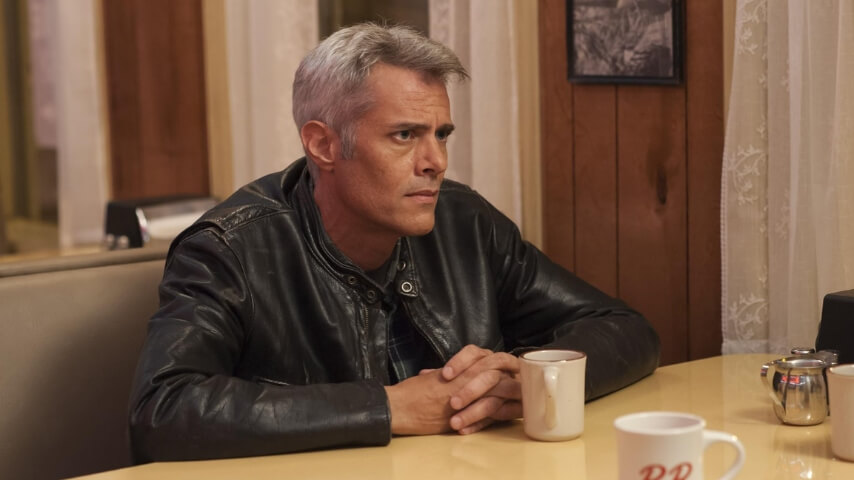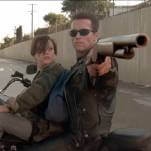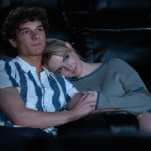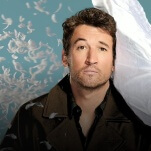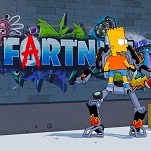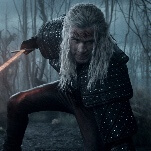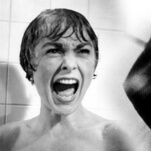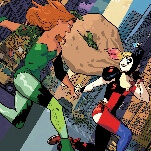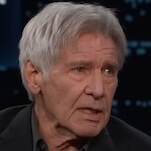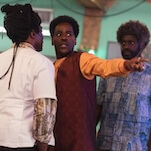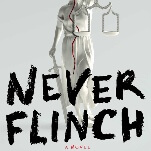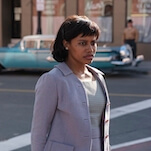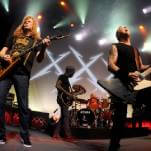Looking at a digital map he’s compared to Maj. Briggs’ sketched-out directions, Sheriff Frank Truman tells Hawk, “By my reckoning, this is where we’re going. But there’s no road. The road’s gone.”
Dale Cooper, walking numbly through Dougie Jones’ life, might feel the same. He has a sense of something he’s stumbling toward, and that sense intensifies in the face of certain objects, ideas, and phrases. He fumbles to touch every badge he sees, he feels recognition stir when he sees a fringed American flag in a government office building, he savors the flavor of coffee but also glances around as if it’s sparking some deeper meaning in his hollowed-out mind. And he loves cherry pie.
These associations and intimations of the man he once was are more like Maj. Briggs’ coded message and line drawing than they are a map back to his own identity. Even with visions of the one-armed man beckoning him on, Dale Cooper is still bumbling through the incomprehensible world, feeling his way back moment by excruciating moment.
That’s deliberate.
The title of Twin Peaks’ revival—a title that originally seemed simple—is starting to feel momentous. “Twin Peaks: The Return” is not just the return of the show Twin Peaks or a return to the town of Twin Peaks. Eleven episodes into “Twin Peaks: The Return,” it’s becoming clear that this isn’t just a show’s unlikely return after more than 25 years; it’s a show about returning.
It’s about nostalgia for a show that never was, for an adorable quirkiness that some audiences and press superimposed over something much grimmer. It’s about the return of actors to great but often misremembered roles. For some of them, it’s a return from the grave; Catherine E. Coulson, Don S. Davis, Miguel Ferrer, and Warren Frost died before the series could be completed.
It’s about a spirit of goodness and strength sent (in the form of Laura Palmer) to redress the balance after humankind unleashes upon itself a new form of evil. In that sense, it’s about the return of mercy. (Not of innocence, because innocence lost cannot be regained and knowledge gained can’t be lost again. Laura knew that.)
Maybe most of all, it’s about Agent Dale Cooper’s lingering return from a quarter-century on another plane. Like the frustrated driver yelling at Bobby Briggs (“We’re late! We have miles to go! Please, we have to get home!”), some viewers are frustrated with the patient, deliberate awakening of Dale Cooper. But the long chapters of Cooper shuffling through Dougie’s life aren’t a distraction from the story. They are the story.
Twin Peaks: The Return isn’t about Dale Cooper swaggering into the rescue. It’s about the odyssey of trying to return to the past—to a youthful vigor long lost, to a once razor-keen mind now clouded, to a world left behind. No matter how fully Cooper recovers from his current state, no matter how much of his crisp professional shine or his piercing intelligence or his charming eccentricity he regains, he will never be the Dale Cooper he knew, or the Dale Cooper we knew, because that man existed 25 years ago.
Two months ago, I said that death, age, and loss loom over this production with searing, sweet honesty, and that becomes truer as the series continues. Dale Cooper can come back, but he’ll never be the dashing young man he was. That dashing young man is gone. No road, however mystical, can take him (or us) back to the past. No map can guide us into our youth again. We can only go into the future and do our best.
The destination is still worthy, and these valiant characters are still undertaking the journey, difficult though it is. Shelly (revealed in “Part 11” to be Shelly Briggs) and Bobby are determined to save their daughter from the same mistakes they made, even if that means throwing themselves bodily into her path. The family Bobby encounters at the intersection near the Double R is another reminder of how patterns of behavior passed down from generation to generation, as Bobby’s meaningful glance from the posturing child in the camo jacket to the posturing father in the camo jacket reinforces. And Shelly’s giddy embrace of Red shows that some people keep making the same old mistakes, following the same dangerous path, year after year.
Gordon and Alfred push ahead with their investigation, knowing it puts them in the path of something worse than mortal danger. Gordon strides toward the abandoned house at 2240 Sycamore in Buckhorn, where William Hastings encountered Maj. Briggs, and as he feels the crackle of some unnatural electricity, he steps forward, not back, to learn whatever he can from this powerful force, and is granted a vision of the woodsmen assembled at the top of a staircase.
Diane watches these events—including William Hastings’ sudden, inexplicable death—with unsettling distant interest. She sees the woodsman winking in and out of existence as he (“it,” Gordon calls him) creeps up to the car where Hastings sits, but turns away and says nothing. Mackley frantically calls for backup after Hastings’ head shatters, but Diane almost smiles as she mutters, “There’s no backup for this.” When she cranes her neck to see the coordinates scrawled on the arm of Ruth Davenport’s corpse, Albert catches her mouthing the numbers as if she’s committing them to memory… and Diane catches him catching her.
Diane is set apart from her companions not just professionally, or by her reluctant continued presence with the FBI team, and not even by her colorful, memorable style. She’s a civilian, and one constantly breaking the rules of the offices and waiting rooms they occupy, lighting up in places where she knows it’s forbidden. She’s part of the group, but conspicuously separate from them, too. Even when they sit together in Mackley’s office, Diane perches on a stool high above her former colleagues. They sit solidly on the ground while Diane looms above them on her spindly, backless seat. Her position gives her a good vantage point for surveying the group, but it also makes her look vulnerable.
“Dougie”’s vulnerability and his deficiencies are obvious to people who serve him. The Mitchums’ chauffeur, who drove him to “the red door” in Lancelot Court, remembers Dougie well enough to cradle him into and out of the car. Phil (Josh Fadem) knows the quickest way to get Dougie into Mullins’ office is to lure him there with coffee. But Dougie’s boss, his doctor, and in this episode, his murderers-turned-friends the Mitchum brothers never seem to see how deeply impaired he is.
Or maybe Bushnell Mullins does see. Mullins escorts “Dougie” arm-in-arm to the Mitchum brothers’ limo, remembers to ask him if he’s got the $30 million check, and knows his infirmities well enough to pat him down instead of waiting for an answer. Battling Bud was savvy enough to take out a secondary policy on the Mitchum brothers’ policy, so he’s recovered the cost of their payout “and then some”; maybe he’s savvy enough to mastermind the fraud scheme and to send the one employee who uncovered it off to the mobsters who want to kill him.
At least, they wanted to kill him. But Bradley Mitchum’s dream saves Cooper’s life and brings the three men together over champagne and cherry pie. The one-armed man beckoned Cooper into the pie shop to buy that life-saving dessert. When he tastes it, a look of pure pleasure breaks across Cooper’s face. But that look deepens into something more when Rodney Mitchum exclaims that “cherry pie is so damn good!”
Like Hawk’s map, which is “very old but still current,” Cooper’s memory of who he once was, and who he is straining to become again, isn’t precise. It’s evocative, sensory, and symbolic. Hawk’s map is full of information that is more valuable than mere location; it tells its readers what to watch for and what to be wary of.
Maggie (Jodee Thelen), the dispatcher at the Twin Peaks Sheriff’s Department, spends most of her day saying the same two phrases over and over. In “The Return: Part 11,” she repeats them four times in just a few seconds. “What’s your location?… Someone’s on the way.”
He’s coming back, bit by tiny bit, in the taste of cherry pie and in the familiar celebration of a “damn good” mouthful of some beloved dish. The chance meeting with Mr. Jackpot’s greatest beneficiary, the once-homeless gambling addict (now dressed in an evening gown, her once-bedraggled hair gleaming as brightly as her smile), also brings a familiar memory to Dale Cooper: the memory of being told with earnest affection how very special and good he is.
Someone’s on the way. “The Return: Part 11” doesn’t deliver the familiar (even clichéd) Twin Peaks menu of coffee and cherry pie. But champagne and cherry pie sounds delicious, and hearing Dale Cooper echo Rodney Mitchum’s “damn fine”? Well, that sounds even better.
Stray observations
- • It is happening again: Little Gersten Hayward (Alicia Witt) is all grown up. The last time we saw her, she was wearing a fairy princess outfit and showing off her skills at the piano; now she’s cowering with Stephen in a stairwell while Becky shoots holes in her apartment door. Her first and only episode of the original series ends with credits rolling as Witt plays piano; “Part 11” ends with credits rolling as a pianist plays.
- • I’m so happy to be wrong about Miriam! Richard thought he’d killed her, but she came crawling through the underbrush, determined to survive. If you thought of Ronette Pulaski crossing that trestle, you’re not alone. There’s even a rusty red bridge (though not the same trestle bridge) in the background of the scene, maybe as a tribute to Ronette’s first appearance.
- • I wasn’t sold on Jim Belushi as Bradley Mitchum, but the little bow of the knees, as he sees the $30 million check, changed my mind completely in one tiny movement.
